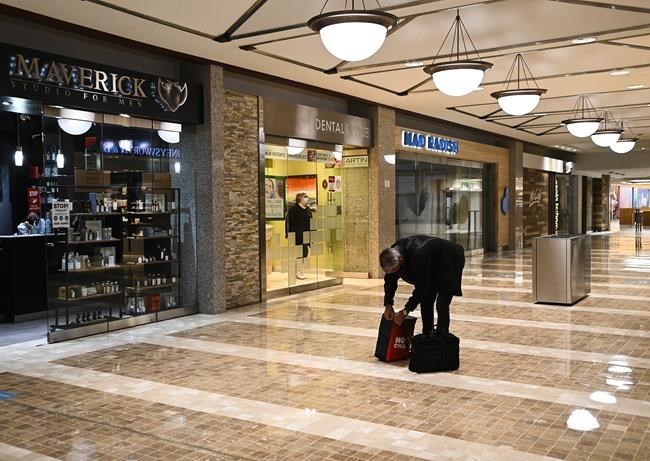TORONTO — Eli Shimonov’s lunch spot reopened after the first COVID-19 shutdown in July, but without the usual hordes of office workers making their way through Toronto’s underground pedestrian network each day, business is “very, very, very, very slow.”
“We’re down probably about 95 per cent,” he said Tuesday during what would have been a busy lunch hour before the pandemic. “Not a great feeling.”
Shimonov owns a Pumpernickel’s sandwich restaurant in the tunnel network known as the PATH. The financial district employees and other office workers who frequented the route disappeared in March when the pandemic forced them to work from home. They have yet to return in their former numbers, though a handful of masked pedestrians were strolling through the space during lunch hour on Tuesday.
The 30-kilometre walkway connects 75 buildings, a handful of subway stations, hotels, tourist attractions and above-ground stores in a winding subterranean shopping centre that’s home to 1,200 businesses, according to the City of Toronto. An estimated 4,600 workers make their living in the system.
Indoor pedestrian walkways that sprung up across North America over the last century offered an escape from the elements in weather-battered cities. In Montreal, workers and shoppers have made use of the RESO, or Underground City, while the Winnipeg Walkway and Downtown Halifax Link offer their own tunnels and skywalks as refuge from the outdoors.
But as cases of COVID-19 continue to climb, these enclosed spaces have lost some of their lustre and their clientele.
In Shimonov’s food court, just a few places are open for takeout – chairs are stacked to deter customers from sitting, and the lights are off even at a McDonald’s counter. But less competition doesn’t mean much when there are no customers to serve, he said.
Without people stopping for lunch or placing catering orders for conferences and meetings, it’s tough to make up for the lost sales.
“The whole PATH right now is really suffering,” Shimonov said.
Grant Humes, executive director of the Toronto Financial District BIA, said a short-term goal during the second wave of COVID-19 is to ensure small retailers are supported.
"In the medium term, our job is to give workers confidence to come back to the office," Humes said in a statement Wednesday.
He pointed to signage promoting mask-wearing and physical distancing. "Protocols are in place and I think office workers will be pleasantly surprised when they’re down here."
Humes expressed confidence that workers will return to their towers eventually, driven by the convenience of downtown Toronto and the collaborative work environments that aren't possible with everyone working over Zoom.
The pandemic has been a "stress-test" of the network and its focus on downtown workers, according to Laura Miller, an associate professor at the University of Toronto's Daniels Faculty of Architecture, Landscape, and Design, who has taught a course on the PATH.
Miller said welcoming other tenants like call centres or after-school programs could invite more users to the network. That would require connecting the PATH more with street-level sites, she said, adding that the pandemic offers a moment for a new approach.
"Historically, the City of Toronto has seen the PATH to be in competition with the vitality of the downtown's street level, but this way of thinking is dated," she said in an email.
"Multi-level access, from the street to the PATH would create better visibility and connectivity ... and more resilience in the PATH, because it could not be understood as a separate part of the city that is out of sight and thus, forgotten."
In the meantime, businesses waiting for their customer base to return have to get through at least another season.
In Winnipeg, about 25 per cent of workers in the downtown core have returned full-time to their offices and another 30 per cent are splitting time between home and office, according to a survey conducted by Probe Research for Downtown Winnipeg BIZ last month.
"That's a big shift when your primary customer base is downtown workers and less than 50 per cent are back full time," said Kate Fenske, CEO of the business improvement zone.
Fenske said her organization is working to promote safety protocols in the walkway, and to make it easier for people to support local businesses - such as working with the city to offer free parking downtown.
Nikky Nikmanesh, manager at a Stitch It garment repair business in the PATH, said she misses the conversations with her customers after 16 years at the shop. Now, with many people's office clothes collecting dust during months of remote work, it's unpredictable whether even one person will stop in each day.
"We can’t complain because this is for everywhere, everybody. We’re just waiting," she said.
After 10 years working in the PATH, cleaner Nas Canalas said the silence in the usually bustling space over the last several months is hard to describe.
"Now, you can see this place, it looks like a ghost town," Canalas said, standing in a nearly empty food court Tuesday. "This is the first time we’ve experienced this since we worked here."
He's starting to notice people trickling back, but he said it's still a lonely, quiet work day in the nearly empty hallways where he and his coworkers are tasked with deep-cleaning every surface.
Canalas said he's grateful to have avoided a layoff so far, but uncertainty about when things will pick up again is tough.
"We are worried also because of our jobs."
This report by The Canadian Press was first published Oct. 15, 2020.
Holly McKenzie-Sutter, The Canadian Press



